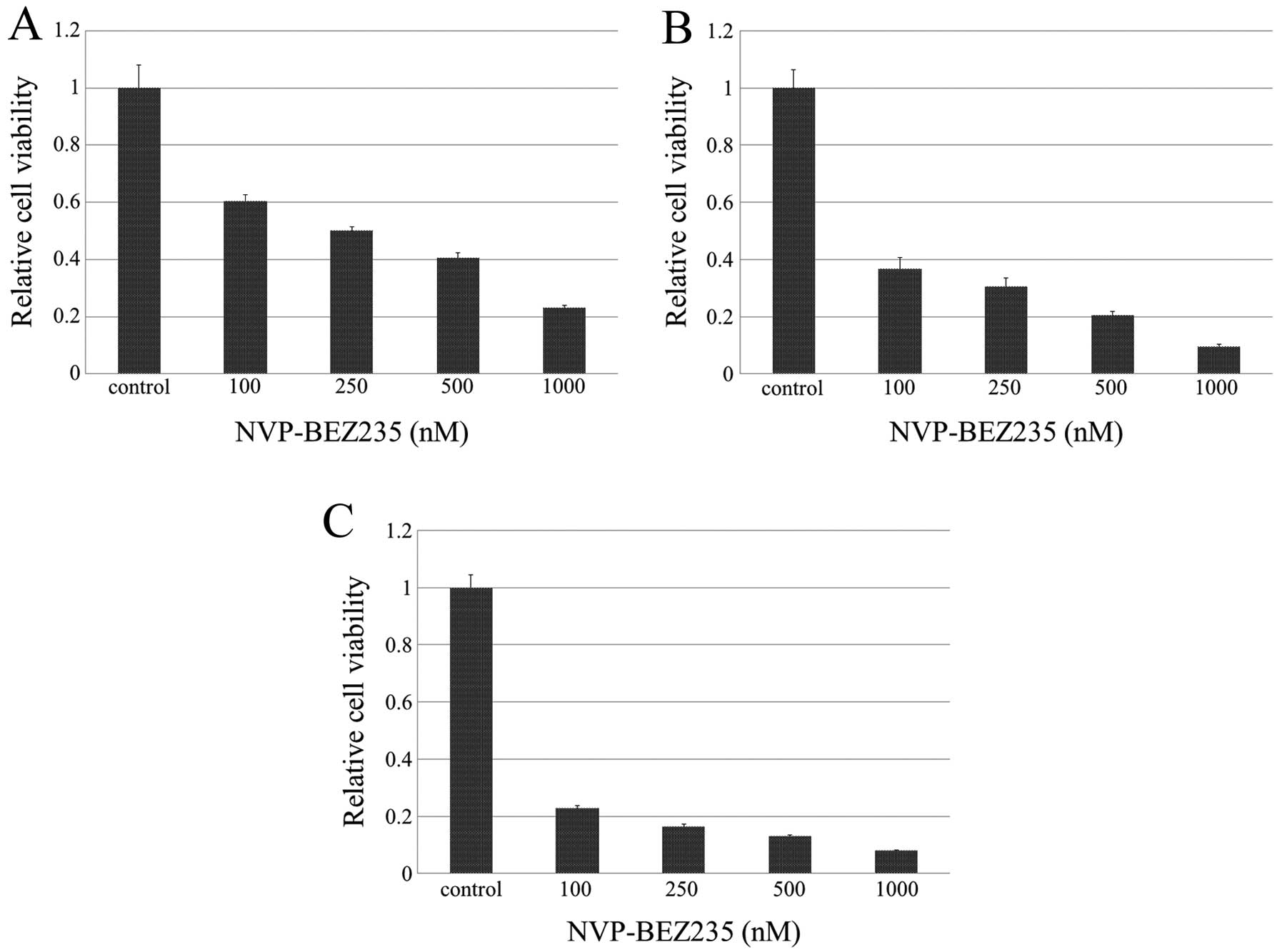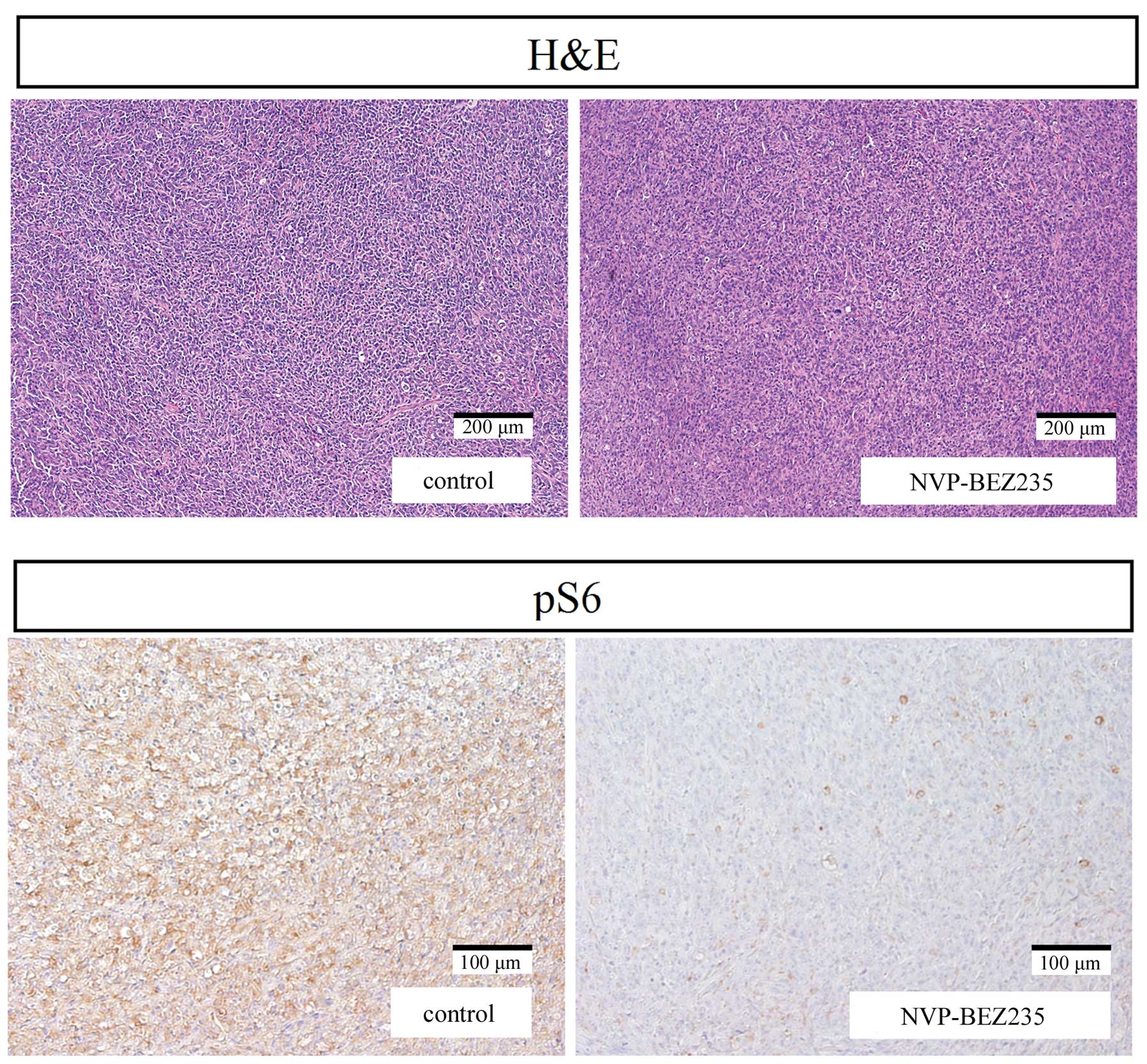|
1
|
Hsieh JT, Dinney CP and Chung LW: The
potential role of gene therapy in the treatment of bladder cancer.
Urol Clin North Am. 27:103–113. ix2000. View Article : Google Scholar : PubMed/NCBI
|
|
2
|
Stein JP and Skinner DG: Radical
cystectomy for invasive bladder cancer: Long-term results of a
standard procedure. World J Urol. 24:296–304. 2006. View Article : Google Scholar : PubMed/NCBI
|
|
3
|
Böhle A and Brandau S: Immune mechanisms
in bacillus Calmette-Guerin immunotherapy for superficial bladder
cancer. J Urol. 170:964–969. 2003. View Article : Google Scholar : PubMed/NCBI
|
|
4
|
Alexandroff AB, Jackson AM, O’Donnell MA
and James K: BCG immunotherapy of bladder cancer: 20 years on.
Lancet. 353:1689–1694. 1999. View Article : Google Scholar : PubMed/NCBI
|
|
5
|
Bai X and Jiang Y: Key factors in mTOR
regulation. Cell Mol Life Sci. 67:239–253. 2010. View Article : Google Scholar
|
|
6
|
Engelman JA: Targeting PI3K signalling in
cancer: Opportunities, challenges and limitations. Nat Rev Cancer.
9:550–562. 2009. View
Article : Google Scholar : PubMed/NCBI
|
|
7
|
Courtney KD, Corcoran RB and Engelman JA:
The PI3K pathway as drug target in human cancer. J Clin Oncol.
28:1075–1083. 2010. View Article : Google Scholar : PubMed/NCBI
|
|
8
|
Seeliger H, Guba M, Kleespies A, Jauch KW
and Bruns CJ: Role of mTOR in solid tumor systems: A therapeutical
target against primary tumor growth, metastases, and angiogenesis.
Cancer Metastasis Rev. 26:611–621. 2007. View Article : Google Scholar : PubMed/NCBI
|
|
9
|
Abe H and Kamai T: Recent advances in the
treatment of metastatic renal cell carcinoma. Int J Urol.
20:944–955. 2013.PubMed/NCBI
|
|
10
|
Wada Y, Takahashi W, Kawano Y and Eto M:
Current status of pharmacotherapy against metastatic renal cell
carcinoma in Japan. Int J Urol. 19:284–295. 2012. View Article : Google Scholar : PubMed/NCBI
|
|
11
|
Chiong E, Lee IL, Dadbin A, Sabichi AL,
Harris L, Urbauer D, McConkey DJ, Dickstein RJ, Cheng T and
Grossman HB: Effects of mTOR inhibitor everolimus (RAD001) on
bladder cancer cells. Clin Cancer Res. 17:2863–2873. 2011.
View Article : Google Scholar : PubMed/NCBI
|
|
12
|
Fechner G, Classen K, Schmidt D, Hauser S
and Müller SC: Rapamycin inhibits in vitro growth and release of
angiogenetic factors in human bladder cancer. Urology. 73:665–668;
discussion 668–669. 2009. View Article : Google Scholar
|
|
13
|
Makhlin I, Zhang J, Long CJ, Devarajan K,
Zhou Y, Klein-Szanto AJ, Huang M, Chernoff J and Boorjian SA: The
mTOR pathway affects proliferation and chemosensitivity of
urothelial carcinoma cells and is upregulated in a subset of human
bladder cancers. BJU Int. 108:E84–E90. 2011. View Article : Google Scholar :
|
|
14
|
Mansure JJ, Nassim R, Chevalier S, Rocha
J, Scarlata E and Kassouf W: Inhibition of mammalian target of
rapamycin as a therapeutic strategy in the management of bladder
cancer. Cancer Biol Ther. 8:2339–2347. 2009. View Article : Google Scholar
|
|
15
|
Serra V, Markman B, Scaltriti M, Eichhorn
PJ, Valero V, Guzman M, Botero ML, Llonch E, Atzori F, Di Cosimo S,
et al: NVP-BEZ235, a dual PI3K/mTOR inhibitor, prevents PI3K
signaling and inhibits the growth of cancer cells with activating
PI3K mutations. Cancer Res. 68:8022–8030. 2008. View Article : Google Scholar : PubMed/NCBI
|
|
16
|
Cho DC, Cohen MB, Panka DJ, Collins M,
Ghebremichael M, Atkins MB, Signoretti S and Mier JW: The efficacy
of the novel dual PI3-kinase/mTOR inhibitor NVP-BEZ235 compared
with rapamycin in renal cell carcinoma. Clin Cancer Res.
16:3628–3638. 2010. View Article : Google Scholar : PubMed/NCBI
|
|
17
|
Maira SM, Stauffer F, Brueggen J, Furet P,
Schnell C, Fritsch C, Brachmann S, Chène P, De Pover A, Schoemaker
K, et al: Identification and characterization of NVP-BEZ235, a new
orally available dual phosphatidylinositol 3-kinase/mammalian
target of rapamycin inhibitor with potent in vivo antitumor
activity. Mol Cancer Ther. 7:1851–1863. 2008. View Article : Google Scholar : PubMed/NCBI
|
|
18
|
Horiguchi Y, Kikuchi E, Ozu C, Nishiyama
T, Oyama M, Horinaga M, Yoshioka K and Tachibana M: Establishment
of orthotopic mouse superficial bladder tumor model for studies on
intravesical treatments. Hum Cell. 21:57–63. 2008. View Article : Google Scholar : PubMed/NCBI
|
|
19
|
Horiguchi Y, Larchian WA, Kaplinsky R,
Fair WR and Heston WD: Intravesical liposome-mediated interleukin-2
gene therapy in orthotopic murine bladder cancer model. Gene Ther.
7:844–851. 2000. View Article : Google Scholar : PubMed/NCBI
|
|
20
|
Horinaga M, Harsch KM, Fukuyama R, Heston
W and Larchian W: Intravesical interleukin-12 gene therapy in an
orthotopic bladder cancer model. Urology. 66:461–466. 2005.
View Article : Google Scholar : PubMed/NCBI
|
|
21
|
Matsumoto K, Kikuchi E, Horinaga M, Takeda
T, Miyajima A, Nakagawa K and Oya M: Intravesical interleukin-15
gene therapy in an orthotopic bladder cancer model. Hum Gene Ther.
22:1423–1432. 2011. View Article : Google Scholar : PubMed/NCBI
|
|
22
|
Fahmy M, Mansure JJ, Brimo F, Yafi FA,
Segal R, Althunayan A, Hicks J, Meeker A, Netto G and Kassouf W:
Relevance of the mammalian target of rapamycin pathway in the
prognosis of patients with high-risk non-muscle invasive bladder
cancer. Hum Pathol. 44:1766–1772. 2013. View Article : Google Scholar : PubMed/NCBI
|
|
23
|
Hansel DE, Platt E, Orloff M, Harwalker J,
Sethu S, Hicks JL, De Marzo A, Steinle RE, Hsi ED, Theodorescu D,
et al: Mammalian target of rapamycin (mTOR) regulates cellular
proliferation and tumor growth in urothelial carcinoma. Am J
Pathol. 176:3062–3072. 2010. View Article : Google Scholar : PubMed/NCBI
|
|
24
|
Korkolopoulou P, Levidou G, Trigka EA,
Prekete N, Karlou M, Thymara I, Sakellariou S, Fragkou P, Isaiadis
D, Pavlopoulos P, et al: A comprehensive immunohistochemical and
molecular approach to the PI3K/AKT/mTOR (phosphoinositide
3-kinase/v-akt murine thymoma viral oncogene/mammalian target of
rapamycin) pathway in bladder urothelial carcinoma. BJU Int.
110:E1237–E1248. 2012. View Article : Google Scholar : PubMed/NCBI
|
|
25
|
Park SJ, Lee TJ and Chang IH: Role of the
mTOR pathway in the progression and recurrence of bladder cancer:
An immunohistochemical tissue microarray study. Korean J Urol.
52:466–473. 2011. View Article : Google Scholar : PubMed/NCBI
|
|
26
|
Sun CH, Chang YH and Pan CC: Activation of
the PI3K/Akt/mTOR pathway correlates with tumour progression and
reduced survival in patients with urothelial carcinoma of the
urinary bladder. Histopathology. 58:1054–1063. 2011. View Article : Google Scholar : PubMed/NCBI
|
|
27
|
Seager CM, Puzio-Kuter AM, Patel T, Jain
S, Cordon-Cardo C, McKiernan J and Abate-Shen C: Intravesical
delivery of rapamycin suppresses tumorigenesis in a mouse model of
progressive bladder cancer. Cancer Prev Res (Phila). 2:1008–1014.
2009. View Article : Google Scholar :
|
|
28
|
Vasconcelos-Nóbrega C, Pinto-Leite R,
Arantes-Rodrigues R, Ferreira R, Brochado P, Cardoso ML, Palmeira
C, Salvador A, Guedes-Teixeira CI, Colaço A, et al: In vivo and in
vitro effects of RAD001 on bladder cancer. Urol Oncol.
31:1212–1221. 2013. View Article : Google Scholar
|
|
29
|
Gerullis H, Eimer C, Ecke TH, Georgas E,
Freitas C, Kastenholz S, Arndt C, Heusch C and Otto T: A phase II
trial of temsirolimus in second-line metastatic urothelial cancer.
Med Oncol. 29:2870–2876. 2012. View Article : Google Scholar : PubMed/NCBI
|
|
30
|
Carracedo A, Ma L, Teruya-Feldstein J,
Rojo F, Salmena L, Alimonti A, Egia A, Sasaki AT, Thomas G, Kozma
SC, et al: Inhibition of mTORC1 leads to MAPK pathway activation
through a PI3K-dependent feedback loop in human cancer. J Clin
Invest. 118:3065–3074. 2008.PubMed/NCBI
|
|
31
|
O’Reilly KE, Rojo F, She QB, Solit D,
Mills GB, Smith D, Lane H, Hofmann F, Hicklin DJ, Ludwig DL, et al:
mTOR inhibition induces upstream receptor tyrosine kinase signaling
and activates Akt. Cancer Res. 66:1500–1508. 2006. View Article : Google Scholar
|
|
32
|
Gupta S, Hau AM, Beach JR, Harwalker J,
Mantuano E, Gonias SL, Egelhoff TT and Hansel DE: Mammalian target
of rapamycin complex 2 (mTORC2) is a critical determinant of
bladder cancer invasion. PLoS One. 8:e810812013. View Article : Google Scholar : PubMed/NCBI
|
|
33
|
Connor J, Bannerji R, Saito S, Heston W,
Fair W and Gilboa E: Regression of bladder tumors in mice treated
with interleukin 2 gene-modified tumor cells. J Exp Med.
177:1127–1134. 1993. View Article : Google Scholar : PubMed/NCBI
|
|
34
|
Fidler IJ: Critical factors in the biology
of human cancer metastasis: Twenty-eighth G.H.A. Clowes memorial
award lecture. Cancer Res. 50:6130–6138. 1990.PubMed/NCBI
|
|
35
|
Ratliff TL: Role of animal models in
understanding intravesical therapy with bacille Calmette-Guérin.
Clin Infect Dis. 31(Suppl 3): S106–S108. 2000. View Article : Google Scholar
|
|
36
|
Chin J, Kadhim S, Garcia B, Kim YS and
Karlik S: Magnetic resonance imaging for detecting and treatment
monitoring of orthotopic murine bladder tumor implants. J Urol.
145:1297–1301. 1991.PubMed/NCBI
|
|
37
|
Weldon TE and Soloway MS: Susceptibility
of urothelium to neoplastic cellular implantation. Urology.
5:824–827. 1975. View Article : Google Scholar : PubMed/NCBI
|
|
38
|
Hsu CC, Chuang YC and Chancellor MB:
Intravesical drug delivery for dysfunctional bladder. Int J Urol.
20:552–562. 2013. View Article : Google Scholar : PubMed/NCBI
|
|
39
|
Dalbagni G, Russo P, Sheinfeld J, Mazumdar
M, Tong W, Rabbani F, Donat MS, Herr HW, Sogani P, dePalma D, et
al: Phase I trial of intravesical gemcitabine in bacillus
Calmette-Guérin-refractory transitional-cell carcinoma of the
bladder. J Clin Oncol. 20:3193–3198. 2002. View Article : Google Scholar : PubMed/NCBI
|















